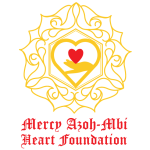Orbituary The Azoh- Mbi and Egbe families of Awing, Santa and Eyanchang Manyu – Central, announce the transition into eternity of their wife, mother, daughter, sister and auntie. Mrs. Mercy Azoh-Mbi NÉe Enow-Mbi Egbe The Death occurred on Sunday July 02, 2023 at the Heart Hospital in Pretoria, South Africa following a protracted illness. Repatriation to Cameroon and funeral arrangements will be announced later. Solomon Azoh-Mbi High Commissioner of the Republic of Cameroon to the Republic of South Africa.
OFFICIAL LAUNCH OF THE MERCY AZOH-MBI HEART FOUNDATION OTTAWA
OFFICIAL LAUNCH OF THE MERCY AZOH-MBI HEART FOUNDATION The Mercy Azoh-Mbi Heart Foundation will be officially launched in OTTAWA on September 19, 2024. The book MIRACLE OF MERCY, which presents the Foundation’s raison d’être, will also be officially launched on this occasion. Rental: Gloucester Presbyterian Church, 91 Pike St, Ottawa ON K1T3J6
OFFICIAL LAUNCH OF THE MERCY AZOH-MBI HEART FOUNDATION Yde
OFFICIAL LAUNCH OF THE MERCY AZOH-MBI HEART FOUNDATION The Mercy Azoh-Mbi Heart Foundation will be officially launched in YAOUNDÉ on August 27, 2024. The book MIRACLE OF MERCY, which presents the Foundation’s raison d’être, will also be officially launched on this occasion. Rental: Hilton Hotel, Yaoundé
THE MERCY AZOH-MBI HEART FOUNDATION HEALTH
Health and Hope – From Heart to Heart In a world often divided by barriers—geographic, economic, and social—The Mercy Azoh-Mbi Heart Foundation stands as a beacon of unity, compassion, and healing. Rooted in the core values of service, love, and access to quality healthcare, this foundation is dedicated to bridging the gap between need and care, one heartbeat at a time. A Heartfelt Mission Founded in honor of a legacy built on compassion, The Mercy Azoh-Mbi Heart Foundation is committed to bringing lifesaving cardiac care and preventative health services to underserved communities. With a special focus on vulnerable populations—especially children and women—the foundation’s mission is clear:“To deliver health and hope from heart to heart.” Changing Lives Through Health Access For many in impoverished regions, heart disease remains a silent killer. The foundation tackles this challenge through: Free heart screenings and diagnostic services Medical missions with skilled cardiac specialists Sponsorship for surgeries and advanced treatments Health education and awareness programs These efforts not only save lives—they empower individuals and families with knowledge and support for long-term wellbeing. From Compassion to Action Every outreach project, every surgical intervention, every child’s heartbeat restored is a testament to what happens when compassion becomes action. The Mercy Azoh-Mbi Heart Foundation partners with hospitals, clinics, global medical teams, and volunteers who share the vision of equity in healthcare. Stories of Hope Behind every heartbeat is a story—stories of children who now run and play without chest pain, mothers who can carry their babies without fainting, fathers who’ve regained strength to provide for their families. These are not just medical triumphs—they’re stories of renewed hope, made possible by the generosity of donors and the tireless work of volunteers. How You Can Join the Mission You don’t have to be a doctor to save a life. Support the Foundation’s mission by: Donating to fund surgeries and outreach efforts Volunteering your time or expertise Sponsoring a heart patient Sharing the cause on social media Every act of kindness ripples outward—from one heart to another. ❤️ Because every heart deserves a chance to heal. Every life deserves a chance to thrive. Join The Mercy Azoh-Mbi Heart Foundation. Together, let’s give the gift of health and hope—from heart to heart.




